The direction headstones face isn't arbitrary; it's a fascinating blend of historical tradition, practical considerations, and evolving cultural norms. While there's no single universal answer, understanding the historical context and various influencing factors reveals a compelling story.
Why Do Headstones Face a Certain Way?
The most common orientation for headstones is eastward, with the head of the deceased facing the rising sun. This practice has roots in ancient traditions and religious beliefs. Many associate it with the concept of resurrection and the promise of eternal life symbolized by the sunrise. Christians, in particular, have historically connected this orientation to the resurrection of Christ.
However, it's crucial to understand that this isn't a rigid rule. Throughout history and across cultures, variations exist. Several factors influence the direction headstones face:
1. Religious Beliefs and Traditions:
- Christianity: The eastward orientation is prevalent but not absolute. Local customs and specific cemetery layouts often override strict adherence to this practice.
- Other Religions: Different faiths have their own traditions regarding burial and memorialization, which may influence the direction of headstones. Some cultures may prioritize other directions based on their cosmological beliefs.
- Secular Practices: In secular cemeteries, headstone orientation is less governed by religious dogma and more influenced by practical considerations like the layout of the cemetery itself.
2. Cemetery Layout and Practical Considerations:
- Space and Design: The physical layout of a cemetery often dictates the direction of headstones. To maintain order and efficient use of space, cemeteries might employ uniform orientations for rows of headstones.
- Accessibility: Headstone placement needs to be accessible for visitors and for maintenance.
- Natural Features: The terrain of a cemetery might influence the orientation of headstones for practical reasons.
3. Family Preferences and Personal Choices:
In modern cemeteries, the families of the deceased often have a greater say in the orientation of headstones. Personal preferences, family traditions, or even a desired view might influence the final placement.
What if Headstones Don't Face East? Are There Other Common Orientations?
While eastward facing is a common practice, variations exist:
- Southward: In some areas, particularly those with predominantly southern exposure, headstones may face south to maximize sunlight.
- Northward/Westward: These orientations are less common but are sometimes seen due to specific cemetery designs or local customs.
Are There Any Modern Trends in Headstone Orientation?
In contemporary cemeteries, the strict adherence to traditional eastward orientation has lessened. The decision is often a collaborative effort between the cemetery and the family, balancing tradition with practicality and personal preferences.
Does the Orientation of Headstones Impact Anything?
Beyond symbolic interpretations, the orientation of a headstone doesn't significantly impact anything else. Its primary function remains as a respectful marker of the deceased.
This exploration hopefully clarifies the multifaceted nature of headstone orientation, moving beyond a simple answer to reveal the rich historical and cultural nuances behind this practice. The direction a headstone faces is a reflection of a combination of factors, highlighting the varied traditions and influences shaping our approach to death and remembrance.
